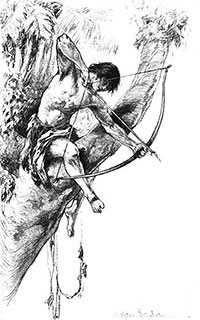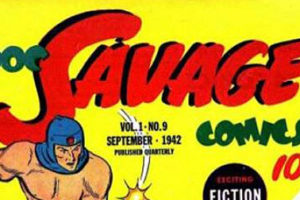
Edgar Rice Burroughs (1875-1950) is a well-known pulp writer who created Tarzan and John Carter of Mars, two of his best-known creations.
Like many pulp fans, I discovered him at an early age and read many of his works. During middle and high school I read most of what he wrote, except for Tarzan. While I would read the occasional Gold Key Tarzan comics, I never had an interest in reading Tarzan. Go figure.
I did, however, read all the Barsoom, Pellucidar, Caspak, Venus, Moon and many other stories he wrote, mainly his science fiction and some jungle adventures. There were others, mainly his western works, that I didn’t bother with.
Obviously, with Tarzan, Burroughs created the genre of the “jungle man” raised in the wilds that so many other characters tried to copy (Ki-Gor, Ka-Zar, Sheena, and a host of others). His stories on Barsoom and other planets created the “planetary romances” that also inspired a whole range of stories of Earthmen being transported to alien worlds having adventures (saving the princess, fighting bad guys, traveling over strange new worlds, etc).
And Burroughs, unlike most other authors of the time, was able to keep ownership of his works, creating a corporation to maintain the rights. They were so popular that they spawned movies, TV shows, comic books, and comic strips, some running for years, all of which his corporation controlled.
 For those not aware, a quick overview of many of his works. I’ll be doing more in-depth posts in the future.
For those not aware, a quick overview of many of his works. I’ll be doing more in-depth posts in the future.
Tarzan
Tarzan of the Apes, the Lord of the Jungle, Lord Graystoke — most are familiar with this character, having read either the novels, comic books or comic strips, or seeing one of the many movies or TV shows. Tarzan was actually his second work, and appeared in 1912 in Munsey’s All-Story magazine, then in book form in 1914. This is typical of most of his works: first serialized in magazines, then reprinted in book form soon after.
Most know the story: Tarzan’s parents shipwrecked on the Africa coast and die. Rescued as an infant by a she-ape and raised by a group of apes. He soon rediscovers white people, finds a wife, regains his title as an English lord, and has a son. He has wild adventures in Africa, finding lost civilizations and strange creatures. Over 20 books were written about Tarzan, along with several others authorized and not.
Barsoom
Mars, the Red Planet, is called by its inhabitants, “Barsoom.” In Burrough’s first published work, Virginian John Carter (who hints he doesn’t know when he was born, so is he somehow immortal?) finds himself mysteriously transported from post Civil War Arizona to Mars. There he finds a dying world with several different races. The main race is the Red Martians (red-skinned humans who lay eggs), who are organized into various city-states. They are menaced by the roving, violent Green Martians, who have four arms. John rescues a Red Martian princess named Dejah Thoris, and soon marries and has a son and later a daughter. They discover other races, long thought dead, such as the Yellow, Black and White Martian races.
A total of 11 books were written. Later ones star John’s son, daughter or grand daughter. Another Earthman, Ulysses Paxton, who apparently died in World War I, also travels to Mars.
Pellucidar
The idea of the Earth being a hollow sphere is one that several people have claimed. In the Pellucidar series, we find out what is going on. (Pellucidar is the name given by its inhabitants of the interior of the Earth.) In the first book, written in 1914, a pair of adventurers using a boring machine tunnel through the Earth and emerge in Pellucidar. They find a primitive land, where stone age humans are menaced by intelligent dinosaurs called Mahar, who see humans as slaves and food. Over the course of the series, the Earthmen created the beginning of a new civilization, and have adventures in various parts of Pellucidar. Even Tarzan joins them, traveling by zeppelin through a polar opening to the hollow earth.
Venus
Carson Napier plans a rocket trip to Mars, but miscalculates and crashes on Venus, which he finds is covered by jungles and oceans. Like John Carter, he is on a quest to rescue a princess, and has adventures on this strange world.
 Caspak
Caspak
Caspak, the land that time forget, is actually one long novel, though most know it as a trilogy. The lost world of Caspak, located in the South Atlantic is a strange environment in which evolution runs wild, were creatures evolve in their lifetime from primitive creatures to cavemen to Wieroo. Into this world, a group of modern humans (Americans and Germans) enter using a German U-boat during World War I. Most don’t survive, and those who do learn more about this strange world.
Moon series
The Moon series comprised three works, and runs over a long period of time. In the 21st century, Earthmen aiming for Mars crash on the Moon, and find it’s a hollow sphere with two races: one human-like, the other like centaurs. The centaur race (Kalkars) conquer the Moon, and using the technology of the Earthmen, soon the Earth in the 22nd century. In the concluding story, set in the far future 25th century, a descendant and reincarnation (reincarnation plays a big part of the overall story) of one of the explorers is finally able to overthrow the evil Kalkars.
Other stories
Burroughs wrote many other stories. Adventure, science-fiction, western, historical and more. Some I’ve read, some I’ve heard of but not read. Some of the interesting one I read are:
• “The Lost Continent:” At the outbreak of World War I, the U.S. instead isolates itself from Europe, and loses contact with the old world, which sinks into barbarism. The Americans, now a united and advanced civilization two centuries later, knows nothing of the old world until an aerosubmarine crashes in England. Europeans are primitive savages menaced by an empire based in Africa that isn’t that much more advanced.
• “Beyond the Farthest Star:” Intended to be the start of a new series, only two short stories were created. Set in another solar system where several planets in the same orbit share the same atmospheric belt, allowing for travel between them.
• “Cave Girl:” On a lost island, a weakling becomes a man, and pursues a cave girl, unaware that she is actually a lost heiress. Which is good, because image the social stigma had he married a primative cave girl?
• “Monster Men:” Similar to Dr. Moreau, a scientist is experimenting with artificial life, and with his thirteenth experiment, thinks he has created a perfect man, whom he hopes to marry off to his daughter. But thinks go badly.
• “The Lad and the Lion:” This is a strange mix of “Prisoner of Zenda” and Tarzan, to a degree. The lost heir of a small European kingdom, whose throne has been taken by others, is shipwrecked with a lion, whom he befriends and becomes his constant companion and guardian.
For those wanting to learn more about Burroughs (and his creations), there are several good resources out there. One work I hear many recommend which I haven’t read is Richard Lupoff‘s “Master of Adventure: The Lives of ERB.” Bison Books has recently reprinted it. One work I read several years back and enjoyed is Irwin Porges‘ “Edgar Rice Burroughs: The Man Who Invented Tarzan.” Another good one is James Van Hise‘s “Edgar Rice Burroughs’ Fantastic Worlds.”
Reading Burroughs is a great experience, something all true pulp fans should do.



